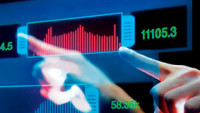 The health of the global economy appears to be starting to give mixed signals if last week’s price action is anything to go by, with crude oil prices rising sharply in anticipation of a rise in global demand with Brent prices hitting a five month high.
The health of the global economy appears to be starting to give mixed signals if last week’s price action is anything to go by, with crude oil prices rising sharply in anticipation of a rise in global demand with Brent prices hitting a five month high.
Copper prices on the other hand, a long standing bellwether of how well the global economy is doing, dropped sharply for the second week in succession after hitting a three year high earlier this month. Part of this may well have had something to do with the fact that the latest economic data from China was quite a bit weaker than expected for August, as the recent rise in the Chinese currency starts to impact on the country’s economic performance.
Despite this European equity markets performed fairly well last week, hitting six week highs, while US equities also hit new record highs, though the FTSE100 underperformed as a result of a stronger pound, and a slide in base metals prices.
Having seen the Bank of England surprise the markets by suggesting that we could well see last year’s emergency rate cut reversed by the end of this year, attention this week is set to turn towards the Bank of Japan as well as the US Federal Reserve, and in particular on how US policymakers will alter their rate rise path projections for the remainder of this year and into next year.
Last week’s performance in bond markets appears to suggest that investors are starting to price in the prospect for some form of additional central bank tightening in the coming months, with yields in German bunds, UK gilts and US treasuries all rising sharply, with UK gilt prices suffering their worst weekly performance this year.
This is a little surprising particularly where the US is concerned given that the path of recent US economic data hasn’t been that great and last week US retail sales showed that the US consumer didn’t release the purse strings anywhere near as much as had originally been thought in June and July. The previous month’s numbers were revised lower, while the August numbers also came in lower than expected. While some of that might have been to do with hurricane Harvey, the prospect of an improvement in the coming months given the damage caused by hurricane Irma seems limited.
The weakness of these numbers is doubly puzzling given that US consumer confidence is at multi year highs, and suggests that even if some Fed members were considering the idea of a rate rise by the end of the year, the window for that is likely to be fairly limited given that the disruption caused by the two Atlantic storms is likely to skew the data for quite some time, thus giving a distinctly cloudy picture of how the US economy is performing.
Despite the weakness in these numbers US markets had another record breaking week with the S&P500 closing at another record high above 2,500, while the Dow Jones had its best week this year. The US dollar index on the other hand slipped back towards the lows seen earlier this month, as speculation shifted again about the prospects as to whether we’ll see another US rate rise this year.
It wasn’t such a good week for the FTSE100 closing at its lowest level since April as the rebound in the pound against the US dollar, as well as a slide in the copper price clobbered it below its long term support at 7,300, and its worst weekly performance in five weeks.
Tensions with North Korea are likely to remain a distraction, however markets appear to be becoming desensitised to them at this time, and short of shots being fired, these tensions are likely to have fairly short term and short lived effects, which helps explain the positive start to the week for Asia shares this morning which in turn is likely to lead to a positive start to this week’s European trading session.
EURUSD – while we hold above the 1.1820 area the upside momentum remains intact with resistance at the 1.2000 area, however a break below 1.1800 opens up the 1.1600 area. For now the larger resistance remains at the 1.2170 level which is the 50% retracement of the 1.3995/1.0340 down move.
GBPUSD – last week’s break above the 1.3320/30 level, has seen the pound test the 1.3620 level and break above the 100 week MA at 1.3400. This weekly close shifts the bias for a potential move to the 1.4000 area. Support now comes in at the 1.3400 area as well as the 1.3320 area.
EURGBP – last week we saw the euro slide sharply below the 100 day MA at 0.8845 to trade down as low as the 0.8774 area. This opens up a move towards the 200 day MA at 0.8700 in the medium term. We now have resistance back at the 0.8850 area as well as the 0.8980 area, which renders the prospect of parity a diminishing prospect for the moment.
USDJPY – we’ve seen the US dollar push up through the 111.00 area which suggests we could see a test of the 112.40 area, however we also have resistance at 111.60. We now have support back down near the 109.80 area.














